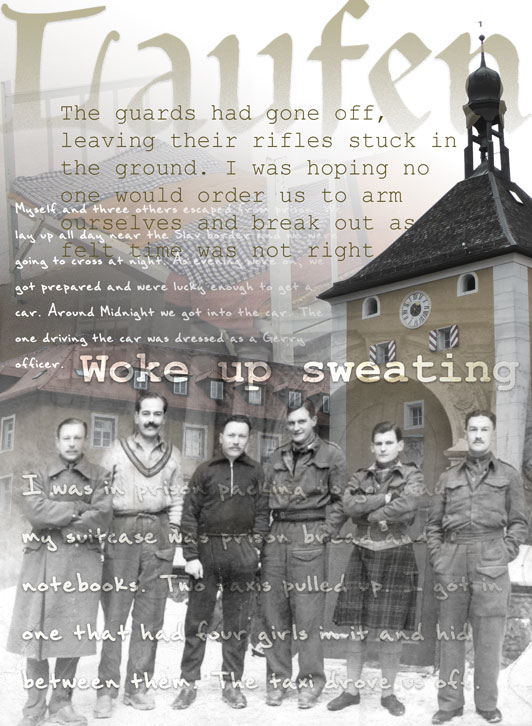
This Article From Issue
July-August 2020
Volume 108, Number 4
Page 200
While teaching a summer course at University College London in 2011, I came across a unique set of dreams recorded in the archives of the Wellcome Library Medical Collection: those from British officers in a World War II Nazi prisoner-of-war camp. From 1940 to 1942, Major Kenneth Hopkins had gathered dream accounts every morning from 79 fellow prisoners being held in Laufen Castle in Bavaria. Hopkins planned to use the data for his dissertation research, but he died of a lung ailment in the camp. These dreams sat unread for decades.
A group of undergraduate students and I scored these accounts using standardized scales that rate dreams for their emotions, types of social interactions, and categories of characters, settings, and objects. We compared the ratings for the soldiers’ dreams to those for dreams from college males of the same time period. Predictably, perhaps, the prisoners’ dreams had more references to food and dead people, and they contained less friendliness, sexuality, and aggression.

Photo montage Barbara Aulicino; Wikimedia Commons CC-SA-3.0; Germany Images David Crossland/Trinity Mirror/Mirrorpix/Alamy Stock Photo
The biggest surprise in the Laufen dreams lay outside our statistical analyses. A small number of the subjects reported dreams about escape. The men who had such dreams usually did so just once, typically expressing a negative attitude toward the idea. Three prisoners recorded several escape dreams each, however, and their dreams were predominantly positive. Some were explicit, as in the case of one who dreamed he and three others snuck out of the prison dressed as Nazi officers and found a car to drive over the Czechoslovakian border, whereupon the dreamer “woke up sweating although with effort not with fear.”
In researching the Laufen camp, I came across references to “The Laufen Six,” a group who escaped from the camp, which the Nazis had been touting as escape-proof. We were amazed to realize that the escapees managed this daring getaway on the same day that three dreamers disappeared from Hopkins’s dream data: Three of the six widely celebrated heroes were in the data set, and all three had dreamed repeatedly about escape before they successfully broke out of prison in real life.
Problem-solving and emotional changes in dreams are difficult to study rigorously. In this case, though, the prisoners’ daytime escape plans clearly affected their dreams. Possibly the process ran in the other direction also.
My career has been dedicated to collecting experiential data on dreaming, which is by its nature subjective and self-reported. Investigating the rare dreams that appear to solve objective problems is especially challenging. I combed biographies and history books and found hundreds of examples of dreams contributing to science, the arts, and world decisions. I also interviewed modern creative dreamers and uncovered current examples of the phenomenon.
In my research, I found myriad examples of dreams helping scientists solve problems, including the story of Margie Profet. When Profet was 10, her school showed the girls a cartoon film about menstruation. “In the cartoon, there was the uterine lining building up and the egg being released,” Margie told me. “Then it ended with this thing, like, if there’s no pregnancy, [the body] just gets rid of everything.” The gifted girl thought, “That doesn’t make sense!”
Biologists at the time explained this major loss of blood, tissue, and nutrients as an inefficient part of the reproductive process. Profet largely forgot her childhood thought, but then in 1989 she had the following dream:
I saw cartoon images of a woman’s body, like the ones in the school film. The ovaries were pale yellow; the uterus was deep red. There were black triangles in the endometrium. Blood was coming out, taking the triangles with it. Then my cat meowed, wanting out—he was quite a nocturnal hunter. I woke up into this half-awake state and thought, “The black things are pathogens—that’s why!”
Profet spent the next three years developing the theory laid out in that dream. She posited that harmful bacteria can enter the womb and fallopian tubes attached to sperm. Menstruation eliminates the threatening intruders as the sloughed-off uterine lining carries off microbes. Profet buttressed her theory with two electron-microscopy studies that showed exactly this process occurring. Her research earned her a 1993 MacArthur Foundation “Genius Grant,” and her theory is now the standard explanation of menstruation in biology.
Profet is in good company. Nobel prize winners have been led by dreams, such as chemist Otto Loewi, who dreamed the experiment that led to the discovery of chemical signaling between nerve cells. Inventions including the automatic sewing machine and the radar-controlled antiaircraft gun were first seen by their inventors in dreams.
How are such specific creative breakthroughs possible, given that dreams typically seem so bizarre? The brain’s physiology during dreaming holds clues.
Your Brain on Dreams
Most dreams occur during the rapid eye movement (REM) stage of sleep. During this stage, an area associated with image formation known as the secondary visual cortex becomes even more active than it is when awake. Another area, the dorsolateral prefrontal cortex, becomes less active. This area is associated with volitional actions and evaluating what is logical and socially appropriate. Several other areas that are not associated with reasoning also have different activity levels when compared with their awake states.
My studies show the importance of dreams for healing deep emotional traumas.
Long before the discovery of these activity patterns, researchers had begun to explore the effects of dreams on creativity and problem-solving. In 1892, Charles Child of Wesleyan University queried 186 college students as to whether they had ever solved a problem in a dream. One-third reported that they had. The students described such dream accomplishments as playing a chess game, solving an algebra problem, detecting a bookkeeping error, and translating a passage from Virgil.
About 80 years later, psychologists developed a technique called dream incubation, which involves directing one’s dream content through bedtime self-suggestions. In 1970, sleep researcher William Dement of Stanford University decided to apply dream incubation to objective problem-solving. He asked 500 students to spend 15 minutes a night trying to solve brainteasers, making sure that they fell asleep with an unsolved problem in mind. Students reported 87 dreams, 7 of which solved a brainteaser.
Researchers often use such puzzles for testing creative problem-solving, but the brainteasers had little personal significance to the test subjects. In Dement’s study, which lasted three nights, all the correct answers came during the first night. He surmised that students lost motivation quickly on problems of little relevance to their lives.
Because of the low rate of success in Dement’s study, I took a different approach for my research in 1996. I asked 79 students to select objective problems that they needed to solve. They thought about the problem at bedtime and told themselves they wanted to dream a solution. They recorded their dreams for a week and noted the ones they thought related to their problem or contained a satisfactory solution. Two research assistants also judged whether the dreams touched on or solved the problems.
Most of my subjects chose problems that appeared simpler than Dement’s brainteasers. Half had dreams they felt included the topic of their problem and at least half of these dreamed a solution to it. The judges largely agreed with those self-evaluations. Simple problems that the dreamer needed to solve did indeed benefit more from dream incubation than the abstract brainteasers. This study is now the best hard data we have on how dreams can contribute to problem-solving.
Types of Problems Solved
The research data I and others have collected demonstrate that any kind of problem can be solved during dreams—especially one a person has been working on intensively while awake. For instance, politicians dreamed solutions to social action crises, generals dreamed battle plans, and students solved their homework. But the problem-solving dreams have tended to cluster in two categories in both my research and the anecdotes.
In the first category are problems with a visual solution. When I polled 400 professionals for my book The Committee of Sleep, 90 percent of visual artists said they had made use of dreams in their work, whereas only 50 percent of writers did, with further drops for the other types of artists such as musicians. The students who solved objective problems were likely to have picked spatial ones. In one instance, a young man saw his furniture fitting perfectly into his new apartment in a wildly different arrangement than he’d been able to come up with while awake.

Photo courtesy Deirdre Barrett; illustration by Barbara Aulicino
The other type of problem that especially benefits from dreams is one in which someone needs to “think outside the box”—in other words, one in which the conventional wisdom is incorrect. For example, chemist August Kekulé came up with the circular structure of the benzene molecule at a time when all known molecules were straight lines with side chains (see Perspective, January–February 2015). In his dream, Kekulé saw a snake made of atoms; at first it was straight but then it reached around to take its tail in its mouth. The dream prompted his breakthrough realization that benzene is a closed ring.
A famous puzzle requiring unconventional thinking is how to make four triangles with six matchsticks. Psychiatrist Morton Schatzman used this puzzle in a dream-incubation challenge to readers of New Scientist magazine in 1983. Hundreds of respondents described trying to solve this puzzle on flat surfaces while awake. The dozen successful dreams showed the matchsticks lifted up in the correct three-dimensional solution, or whimsical versions of teepees or three-sided pyramids.
Post-Traumatic Nightmares
Some of the most powerful examples of dreams helping people solve problems come from trauma survivors, for whom the problem to be solved is their emotional wounds. My studies not only show the importance of dreams for healing deep emotional traumas, but also provide some of the best evidence for how to prompt such dreams.
Trauma survivors often have nightmares about the event: a rape, fire, battle, or other extremely disturbing experience. They say it is like reexperiencing the trauma, and they awaken terrified, the nightmare wiping out any previous gains in peace of mind. I observed the same pattern in 50 Kuwaitis I studied immediately after the 1990 Iraqi invasion and in 200 Americans I studied after the 9/11 attacks. However, clinicians (including myself) noticed that some trauma survivors would occasionally have a mastery dream in which the nightmare took a different turn, and the individual was rescued or fought off the menace. The survivor would awaken feeling comforted. Usually the nightmare would not reoccur after the new mastery dream.
In the 1996 book I edited, Trauma and Dreams, other researchers describe techniques they have developed to assist survivors in coming up with a script for a dream that masters the event in the recurring nightmare. They then coached their clients on how to practice these techniques in therapy sessions or at bedtime.
Emergency physician Barry Krakow consolidated these techniques into a three-session group treatment that he and his colleagues conducted first for groups of rape survivors. Working with 44 survivors, they enabled 22 of the women to achieve mastery in their dreams—a statistically significant result. Krakow and colleagues repeated the procedure through the late 1990s and early 2000s with Vietnam veterans and other traumatized groups, finding similar success with about half of them. Nightmare intervention also improved other post-traumatic stress disorder symptoms, such as daytime anxiety and flashbacks, which the group sessions had not addressed directly.
Creative Dreaming on Demand
All this research—historical anecdotes, my experimental studies, and others’ work—can be synthesized into advice for anyone who wants to incubate a dream about a problem (see box below). Low dream recallers may have more success if they begin by incubating better dream recall. You can increase your recall by telling yourself, just as you are falling asleep, that you want to remember your dreams. Let it be your last thought as you drift off.
Keep a pad and pen by the bed—or keep your smartphone nearby for recording notes. When you first wake up, don’t jump up or turn your attention to anything else. Even if you don’t think you remember a dream, take a minute to see if you woke with any feeling or image. Focus on that, and sometimes a whole dream will come flooding back. You can also simply self-suggest dreaming of a favorite person or place, or having a particular type of dream. Have fun!

American Scientist Comments and Discussion
To discuss our articles or comment on them, please share them and tag American Scientist on social media platforms. Here are links to our profiles on Twitter, Facebook, and LinkedIn.
If we re-share your post, we will moderate comments/discussion following our comments policy.